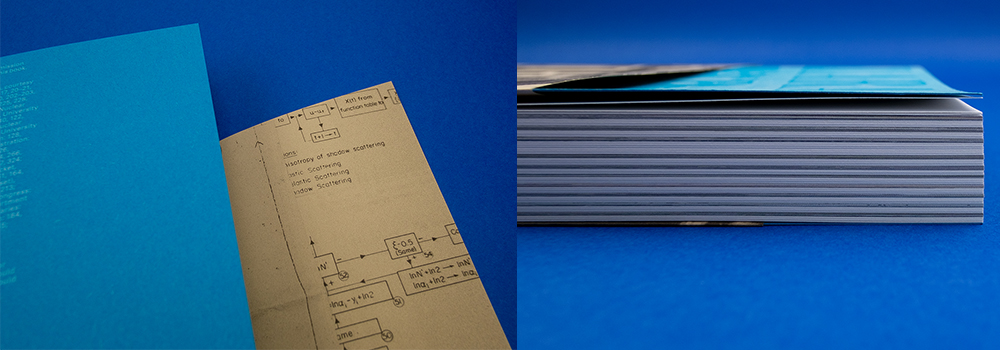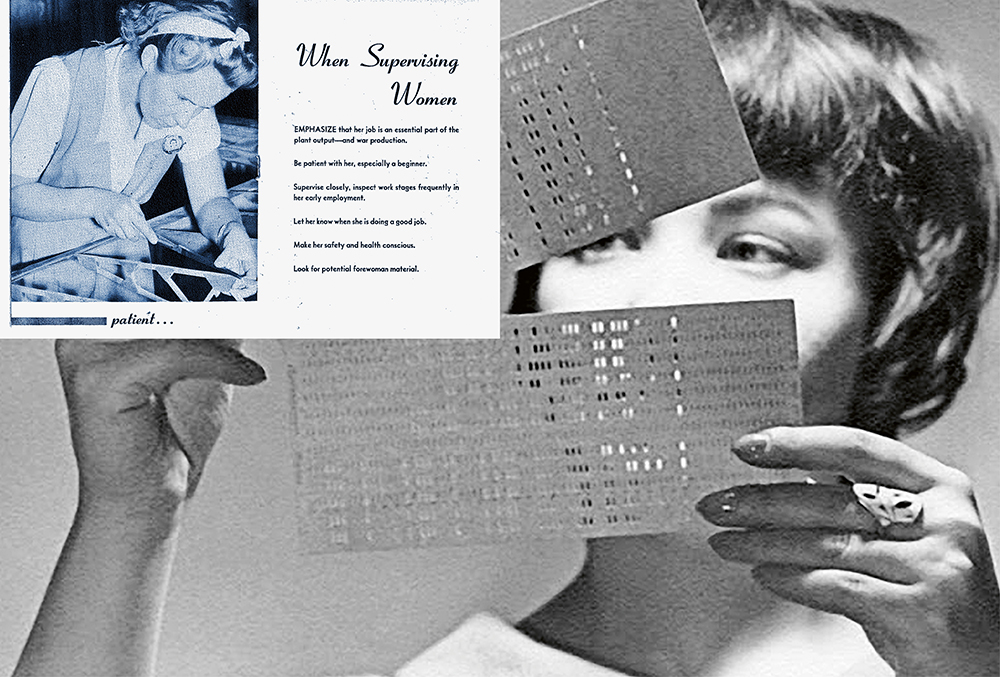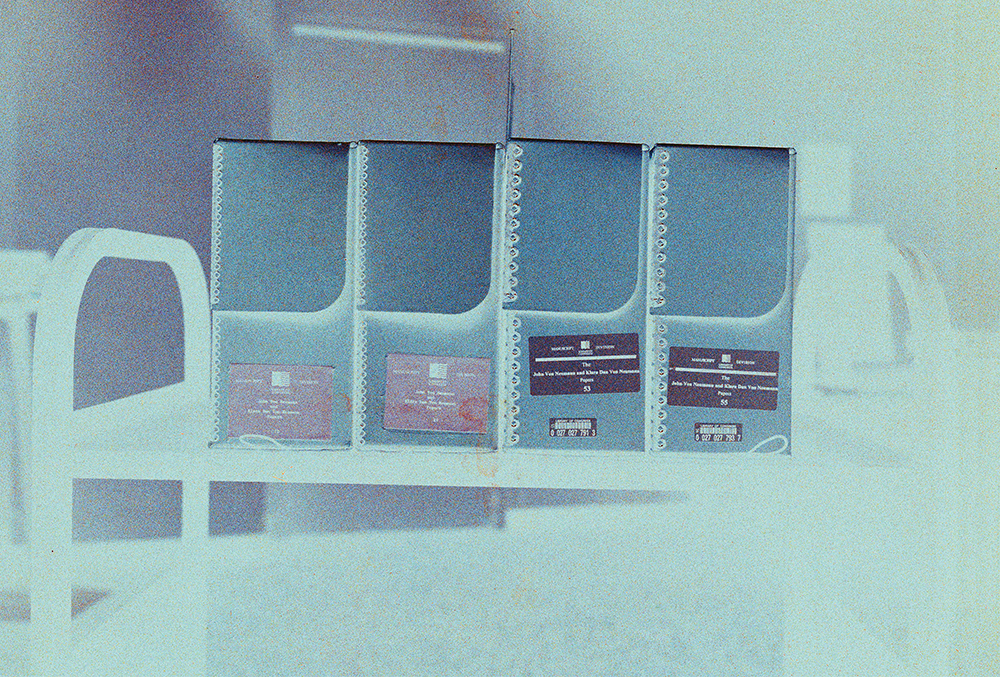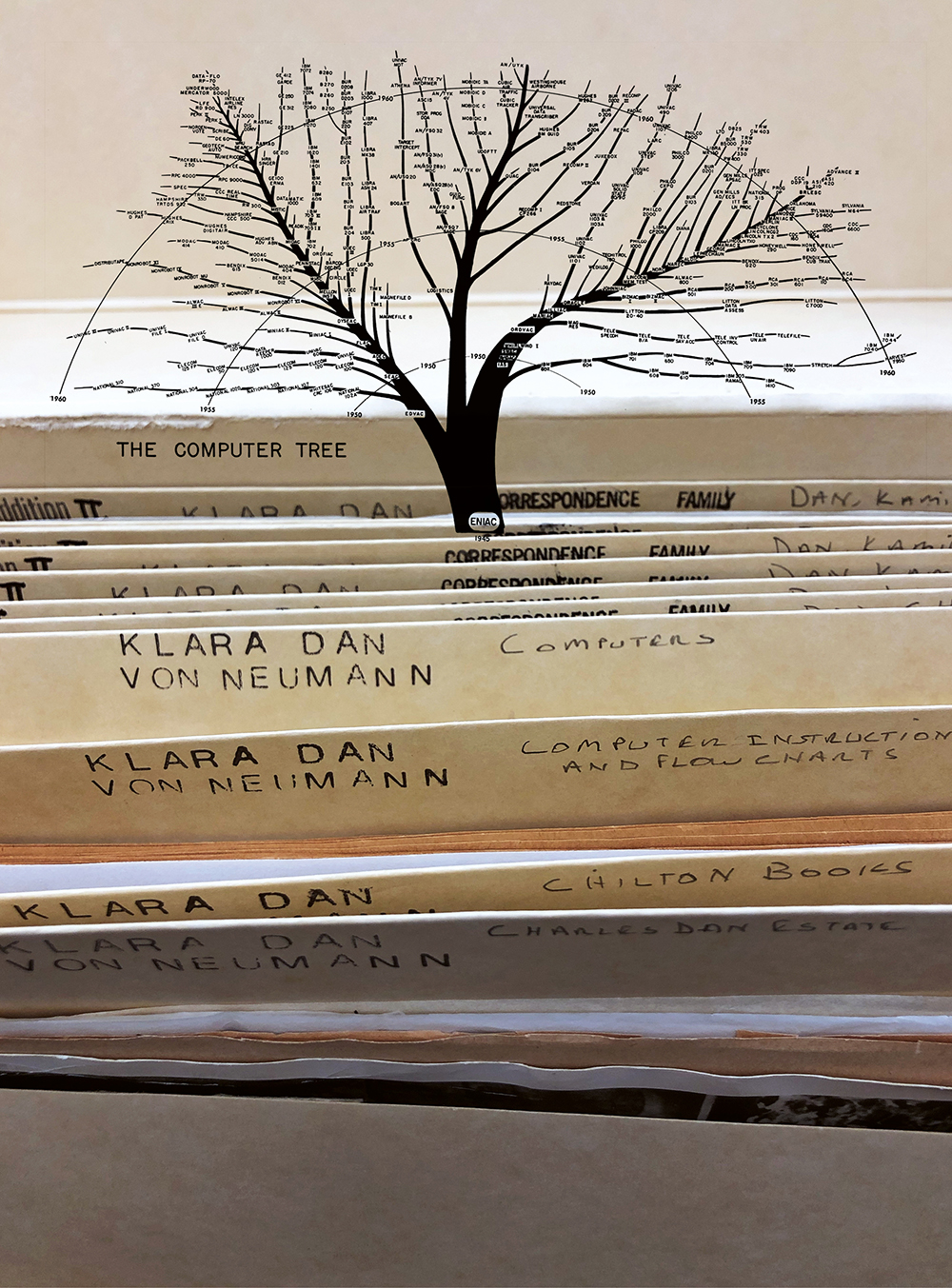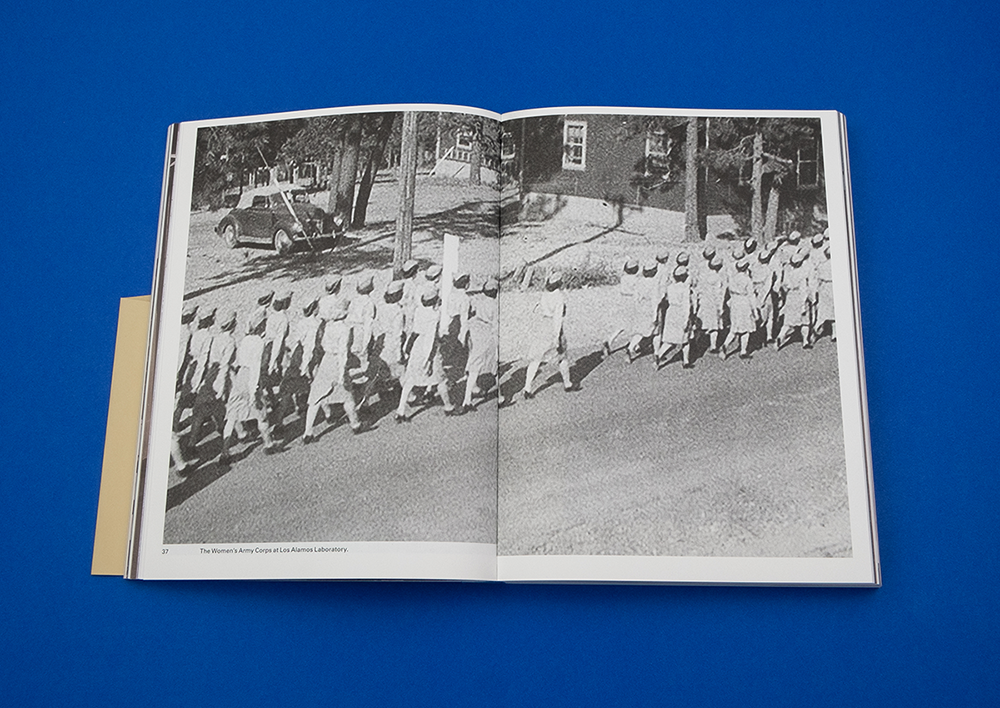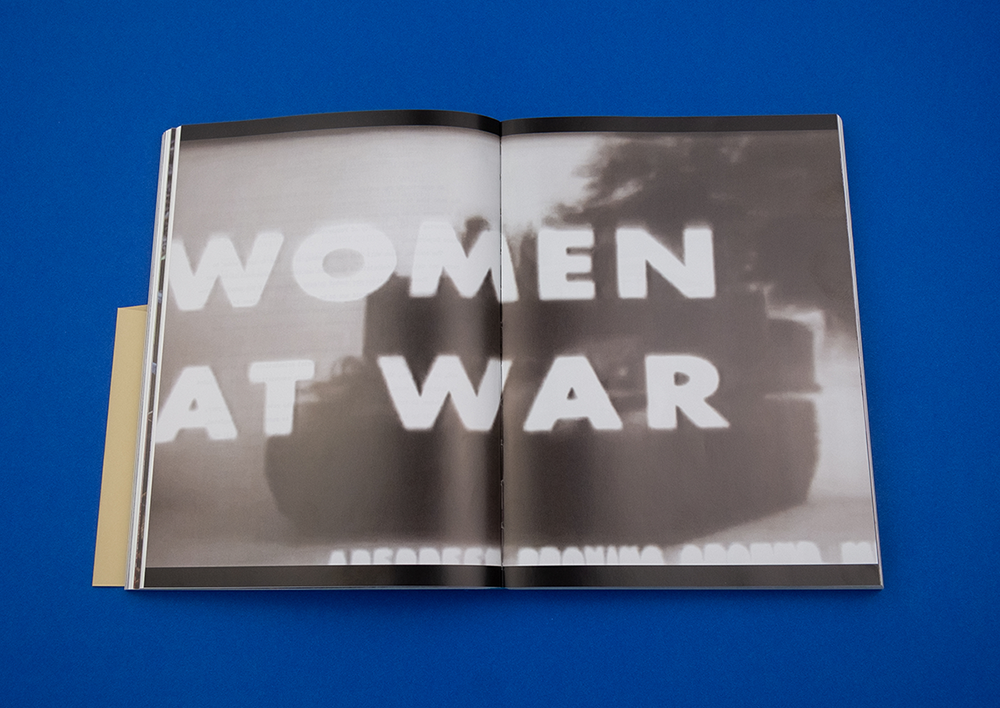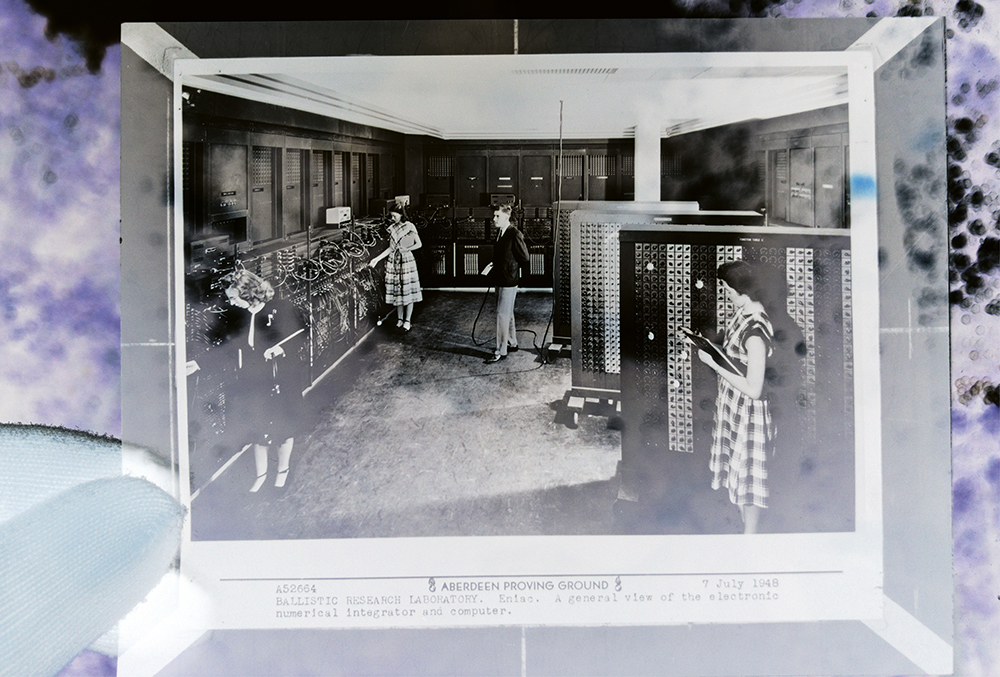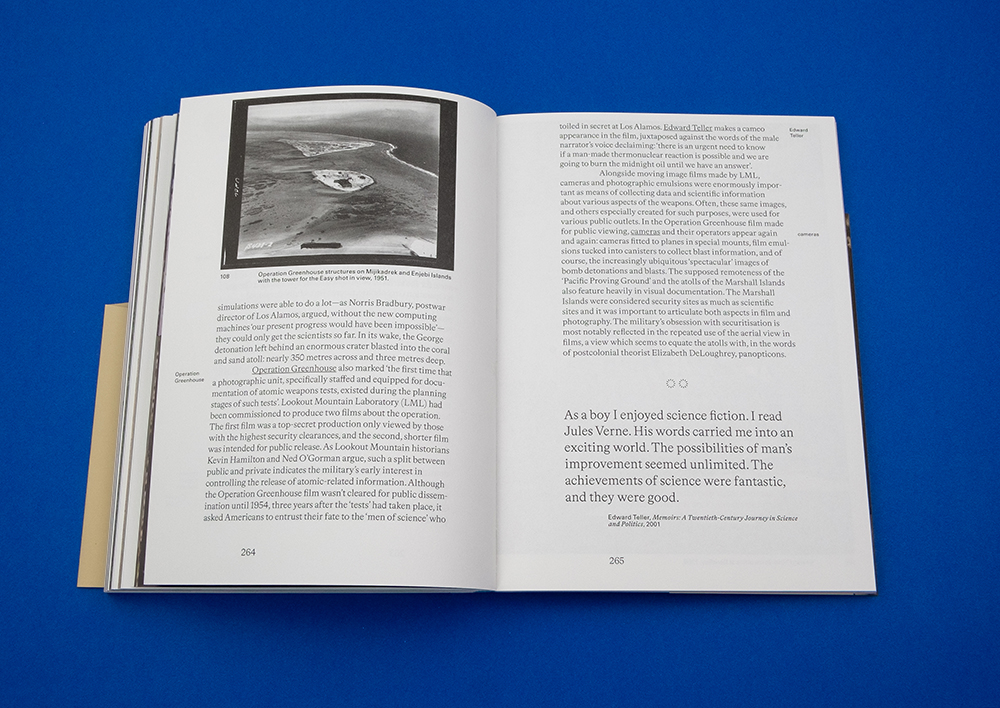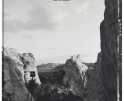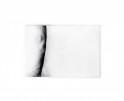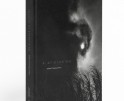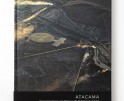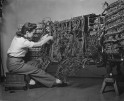Atomic Reactions: Crystal Bennes: Klara and the Bomb
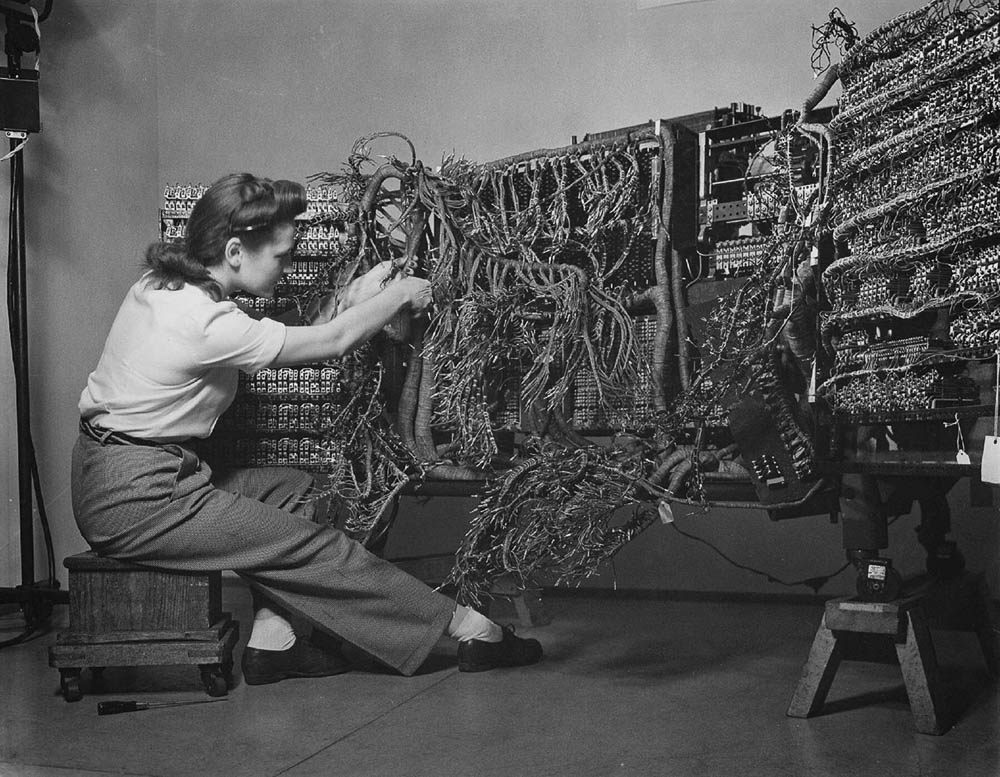
An engineer wiring an IBM 405 Alphabetic Accounting Machine, c. 1935 from Klara and the Bomb, ©Crystal Bennes
Crystal Bennes’ book Klara and the Bomb is a radioactive tapestry. In text punctuated with suites of recombined imagery, Bennes deftly weaves the history of nuclear weapons, the invention of modern computers and the surprising roles women played in these narratives. Through the life of Klara von Neumann, one of the first computer programmers, Bennes follows threads through Klara’s marriage to mathematician John von Neumann, into gender politics and scientific ethics. These are by no means the only threads as she follows the interplay of events that had Klara “swept up by the hurricane force turbulence of international events and global minds.” Archival imagery, fieldwork, Bennes own photographs, de-classified documents, Klara’s letters, and quotes interleave and interrupt the text, allowing other stories to emerge. Bennes’ research-rich work opens narratives, complicating what we thought we knew. This much is certain — the toxic residue from the bomb and the patriarchal culture that defined Klara are still with us.
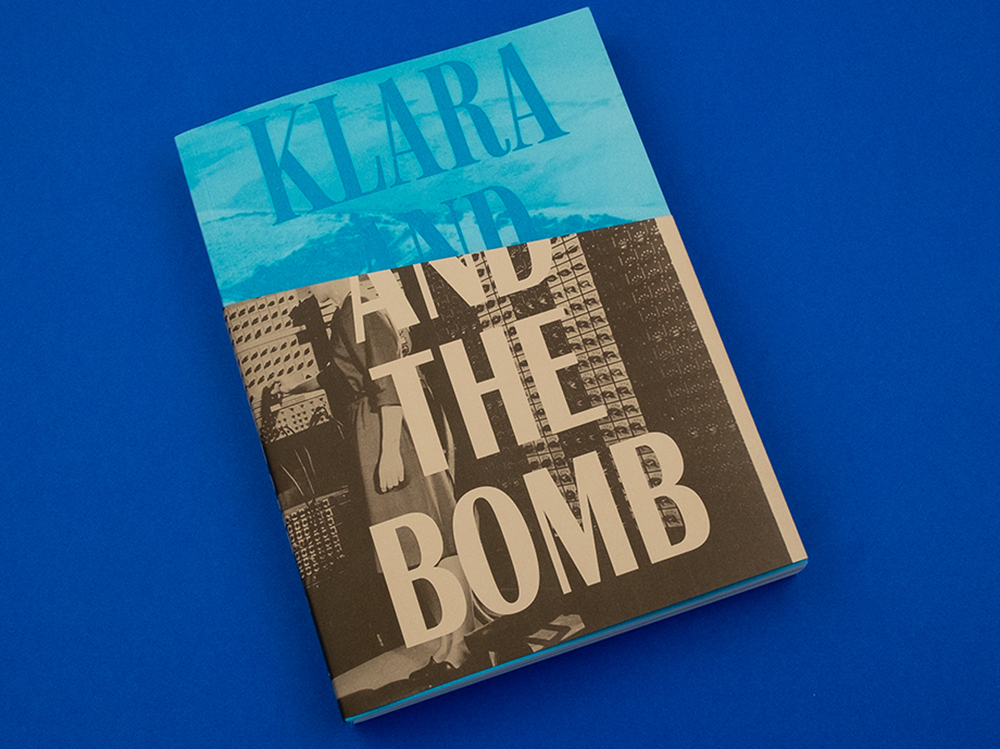
The design of the book encapsulates Bennes’ storytelling in thematic suites of images that are clustered within the text. The cover features a diagonal slice cutting through an archival photograph of female computer programmers—whose work helped build the bomb—rendering them anonymous. Exposed beneath is an aerial view of the Marshall Islands, stripped and contaminated by bomb testing in 1952. Klara von Neumann’s hand-written calculations line the inside dust cover.
What led you to create this book? Was there a pivotal moment that compelled you to bring these histories from the mid-20th century to light?
In early 2022, I completed a practice-based PhD which looked at the histories and uses of gendered representations of nature in the sciences, and certain feminist critiques of physics research culture. In the first year of my PhD, I encountered a book chapter by historian of science, Peter Galison, called ‘Computer Simulations and the Trading Zone’. Galison untangles the history of nuclear weapons development in the U.S. and uses this metaphor of the ‘trading zone’ to explain how people from a broad swathe of different disciplines came together to solve the the technical problem of how to produce atomic bombs.
Two things in the chapter particularly interested me. The first was the clear link Galison makes between the invention of modern computers and the invention of nuclear weapons. He argues very persuasively that physicists wouldn’t have been able to devise atomic bombs without early computers like the ENIAC at their disposal to aid with modelling and simulation.
The second was the fact that many of the scientists’ wives were involved in atomic research, particularly at Los Alamos where secrecy requirements meant that wives were often recruited to carry out various mathematical or data processing tasks. I don’t think I really appreciated just how involved women had been in the work of devising nuclear weapons, but also the computing devices which enabled the research, until reading Peter’s chapter. And this was also the first place I encountered Klara von Neumann’s name—Klara is the central figure in Klara and the Bomb. She was the second wife of noted Hungarian-American mathematician, John von Neumann, who was an academic at Princeton, though he had a hand in many aspects of American military research in the 1940s and ‘50s. This information, fascinating though I found it, wasn’t directly relevant to my PhD research and so it had to be put aside. But I knew that it was something I wanted to come back to and explore in a future project which eventually turned into Klara and the Bomb.
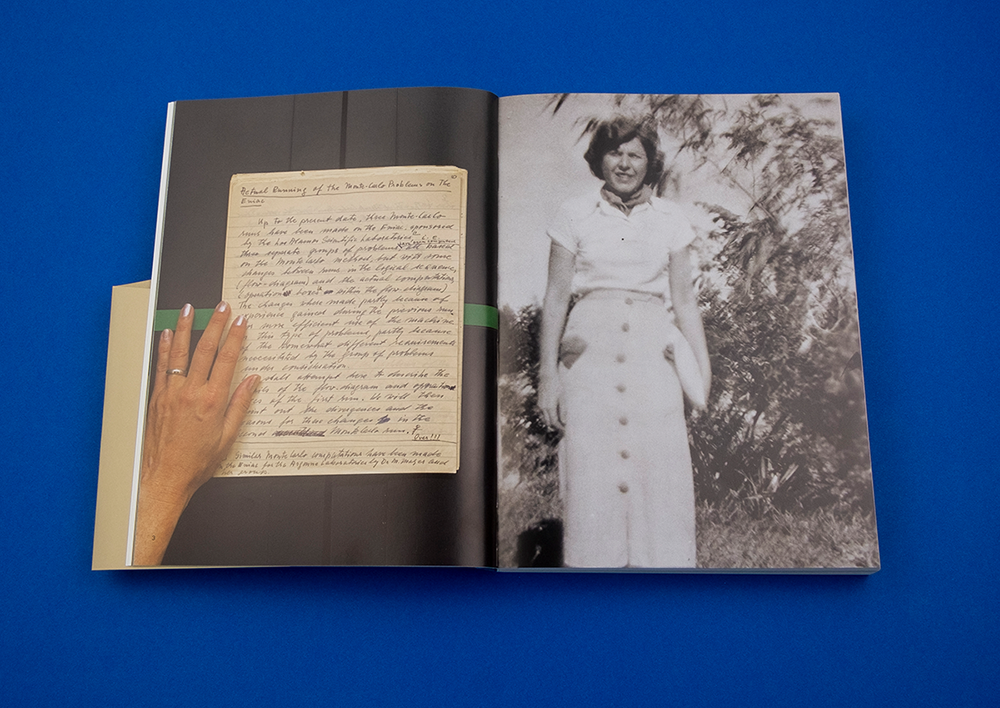
At left: Klara’s handwritten draft of the 1949 report on the ‘Actual Running of the Monte Carlo Problems on the ENIAC’ ©Crystal Bennes
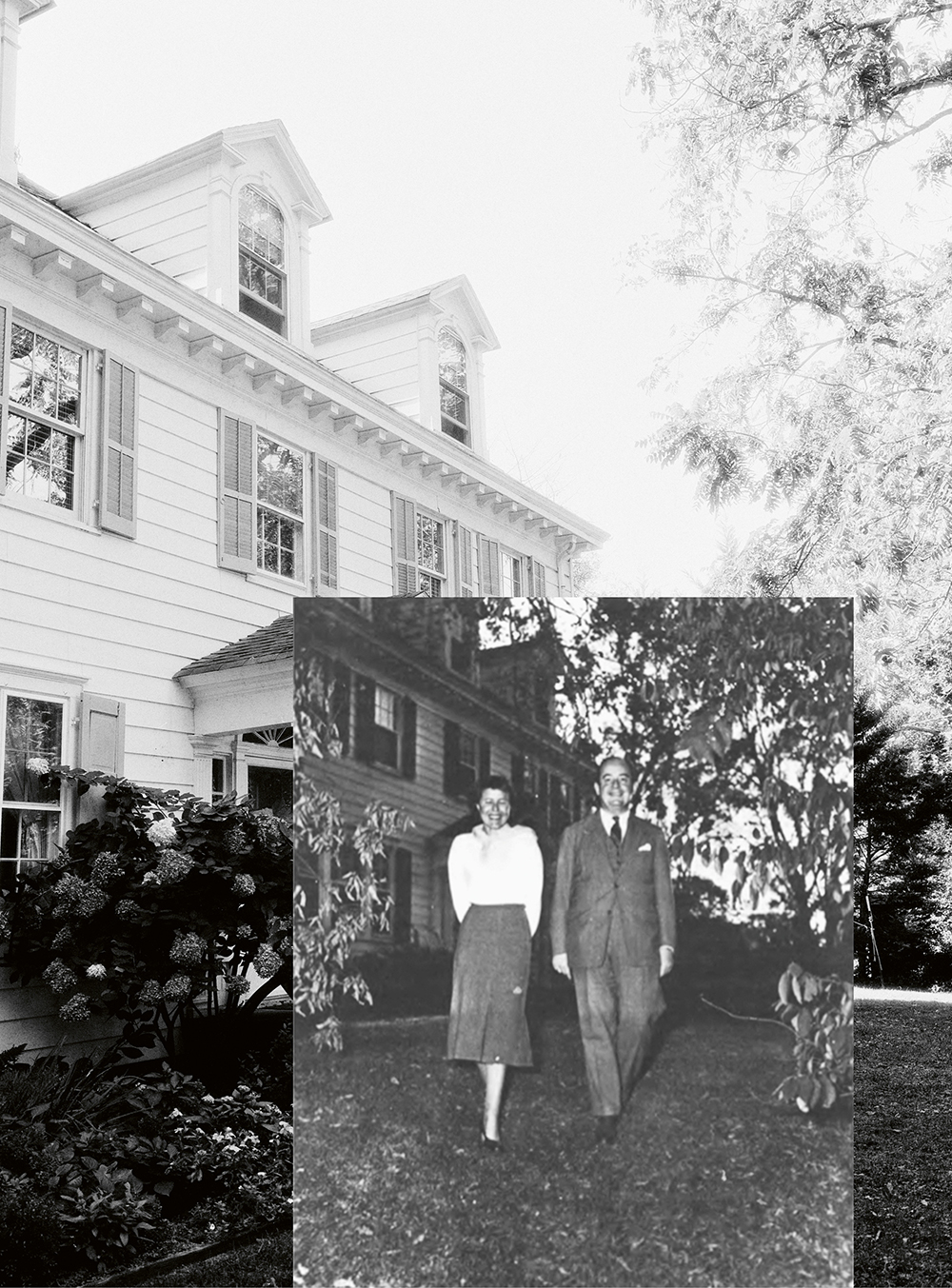
Klara and John von Neumann outside their home in Princeton, New Jersey From Klara and the Bomb, © Crystal Bennes
Your book interleaves suites of imagery with chapters of text, functioning in nuanced ways to complicate the narrative. Can you speak about how you approached juxtaposing archival imagery, your photographs, text and quotes. How do you view the role of the archive in your work?
There are essentially four main components in the book: text, archival images, my photographs of documents and my fieldwork images. Although Klara and the Bomb is ostensibly a photobook, the texts are a hugely important aspect of the book. Text is the backbone of my practice. Reading and writing are the starting point of every single one of my projects. I believe in the affective power of images, but this project brings together and overlaps five interconnected histories, each one of which could have been a separate book, and so I don’t believe that I could have made the project I wanted to make without the explanatory power of the texts.
The book’s source material ranges across a variety of archives, many of which I visited in person, including the Library of Congress and the U.S. National Archives and university libraries and archives like Princeton and the University of Pennsylvania, where the ENIAC was originally created. I also visited the home of John von Neumann’s daughter in Massachusetts to view the manuscript of Klara’s unpublished autobiography.
Many troubling clichés persist around archives, as both institutions and physical spaces—aesthetic clichés like dusty archives but also linguistic clichés around discovery of hidden materials. The writings of Ariella Azoulay have had a significant influence on my work over the last four years and both the processes of making Klara and the book as a finished object are underpinned by much of her thinking on archives as spaces of colonial violence. In Potential History, Azoulay writes of how ‘the masquerading of the archive as a collection of documents is at the basis of the conflation of ontological violence with epistemological violence. The regime of the archive shapes a world, not just distorts the ways it is perceived (its representations)’. She also writes quite a bit about the deceptively neutral aesthetics of the archive and how people who use archival material often write themselves out of the experience, partly as a way of preserving the illusion of the neutrality or objectivity of the archive. This is one of the main reasons why you often see my hand in the images of archival documents. It became my visual shorthand to signify that I acknowledge the impossibility of any kind of archival neutrality.
Something that felt especially relevant to my interest in nuclear colonialism and the impact of the U.S.’s nuclear weapons programme on the residents of the Marshall Islands, as well as my interest in the ‘suppressed histories’ of Klara and the other women in computing, is Azoulay’s unpicking of the relationship between archives and so-called hidden histories. The problem, Azoulay says, with hidden history narratives is that, ‘in fact, these aren’t hidden things or histories but rather open secrets known far beyond the archive and the grammar invented as guardian of its orderly uses’.
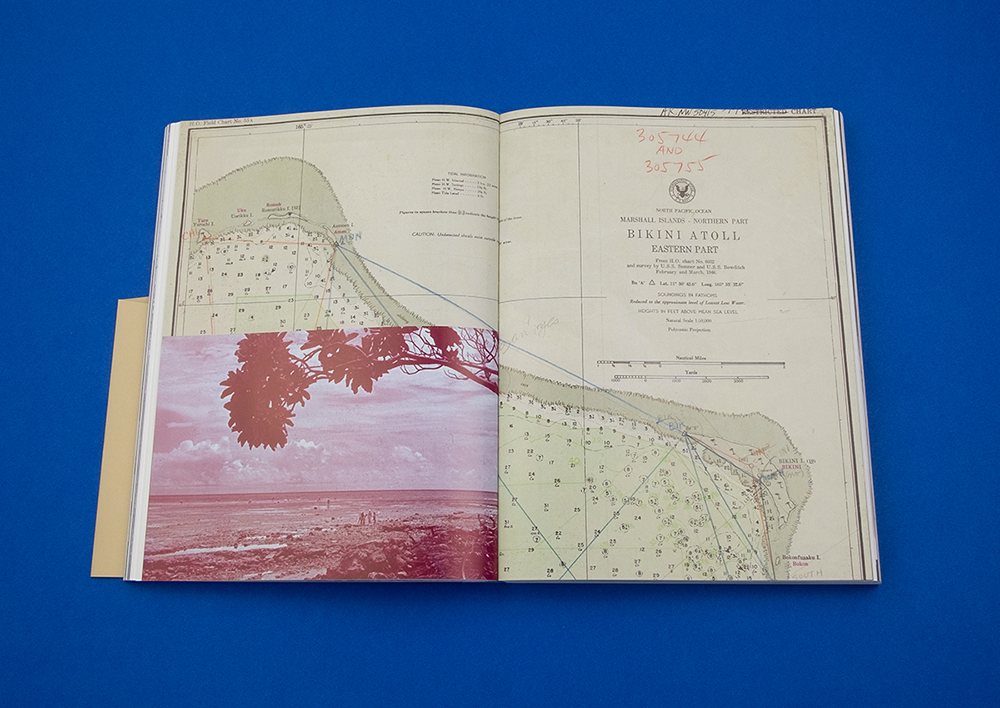 As researchers and artists, we don’t truly discover anything in archives. Whether informal, corporate, governmental, materials in archives have been pre-selected as valuable or worthy of preserving, cataloguing and controlling. This also speaks to the broader question of what hasn’t been preserved or collected or controlled in the archive. This isn’t to suggest that artists should never make use of archives, but I do believe that users have a moral obligation to interrogate where archival material has come from, whose histories have been distorted or reshaped, how materials have previously been used or abused to shape and narrate certain histories, and who does and does not have access to archives and why.
As researchers and artists, we don’t truly discover anything in archives. Whether informal, corporate, governmental, materials in archives have been pre-selected as valuable or worthy of preserving, cataloguing and controlling. This also speaks to the broader question of what hasn’t been preserved or collected or controlled in the archive. This isn’t to suggest that artists should never make use of archives, but I do believe that users have a moral obligation to interrogate where archival material has come from, whose histories have been distorted or reshaped, how materials have previously been used or abused to shape and narrate certain histories, and who does and does not have access to archives and why.
In terms of pulling all of the different materials together, by the time it came to start designing the book, which was done by Carel Fransen of The Eriskay Connection, I had collected an enormous amount of visual material. As a first step, I made a rough outline and sorted the images accordingly. Carel and I both wanted a collaborative design process, so I sent him absolutely everything and the rough outline, but made it clear that I wasn’t wedded to anything other than a loose chronological structure—the book’s timeline plays out over the course of Klara’s life. Carel came back with a completely different way of structuring the book, which was a much better plan than my initial attempt.
We ended up with alternating sections of what we called ‘poetic images’ which are full bleed colour on a satin paper. These are sequenced and grouped as mini stories, each with their own theme and narrative. Interspersed with that we have text pages on an uncoated paper which have more ‘illustrative’ images in black and white. I think it is a very elegant solution for such a complex book in that it allows space for some ambiguity while providing a clear structure for the narrative to unfold.
One recurring thread in the narrative is the essential role photography played in the shaping of the atomic age. Can you share some key ways photography was used in the development, subsequent testing and the lasting impressions we now have?
Fairly early on in the book, there is a rather incredible black and white photograph of a group of ten military photographers standing in front of a large plane with hundreds of cameras spread out in front of them like trophy animals from a big game hunt. A few pages later is a screenshot from a military film made about the residents of Bikini Island who were asked to leave their home for ‘the good of mankind’, in other words, so the U.S. military could drop atomic bombs on it. The text overlay reads ‘they were taking many photos of us’. For me, these two images encapsulate the absolute centrality of photography to shaping narratives around the atomic age, particularly in the U.S. context.
We’ve all seen endless photographs of mushroom clouds and this is what everyone thinks of when they think of nuclear weapons. I open Klara and the Bomb with a nod to Peter Hales’s idea of the atomic sublime and its relation to the iconicity of the mushroom cloud. The U.S. military machine very deliberately circulated images of mushroom clouds in mass media to simultaneously exoticise and familiarise atomic weapons. I very deliberately decided to omit any mushroom cloud images from the book for this reason, but also because there are more important and interesting stories to tell about photography and atomic weapons.
After the detonations over Hiroshima and Nagasaki in 1945, the U.S. military decided to offshore many bomb ‘tests’ to the Marshall Islands. I never use the word ‘test’ to refer to atomic bombs without inverted comas. In my view, there is no such thing as a ‘test’ where nuclear weapons are concerned. Only explosions or detonations.
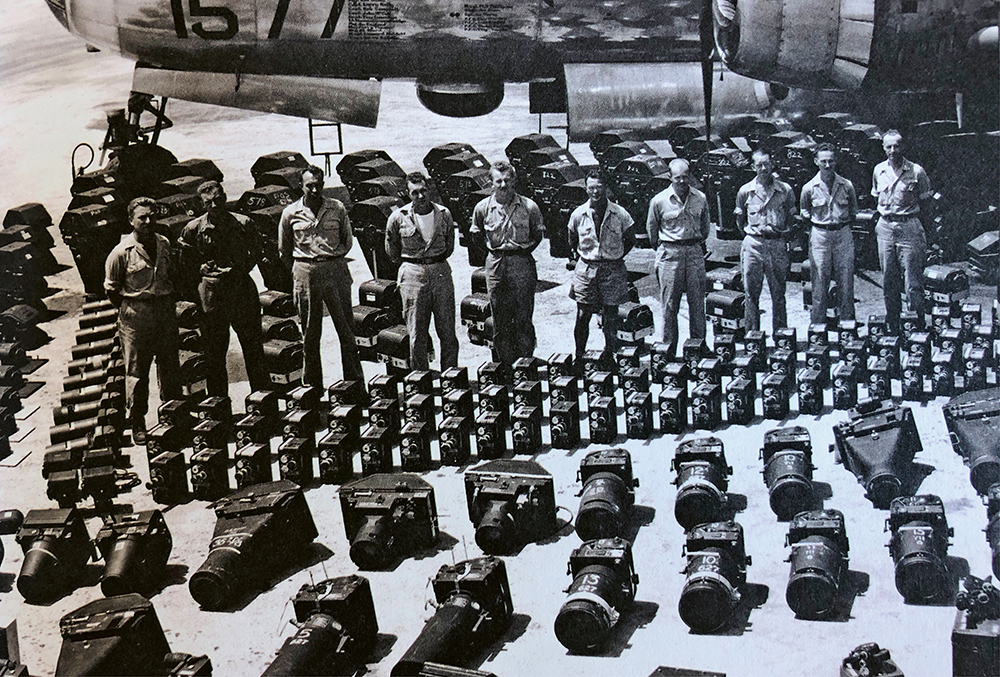
Photographers and their equipment on display in advance of Operation Crossroads, later referred to as Operation Camera by the press ©National Archives and Records Administration
The photo I mentioned above of the group of men with their trophy cameras was connected to the much-publicised Operation Crossroads atomic bomb ‘tests’ at Bikini Atoll in 1946. So much film footage was shot—estimates range from fifty thousand to one million still pictures—that it caused a worldwide shortage of film stock for months afterwards. The press started calling it ‘Operation Camera’. This operation is also the source of the second photo mentioned above, as the negotiations between the U.S. military and Bikini Islanders were filmed, photographed and disseminated in mainstream media outlets. Photography aided the military and the government in promoting and controlling specific narratives around the destructive power of its newest weapon.
Photography was also important to the military as a source of scientific data. High-speed cameras, for example, helped to solve a problem scientists were having of why some weapons produced less than expected blast pressure. But I think that perhaps the most important role played by photography in this period was that it provided for the U.S. government visual evidence of the overwhelming threat of nuclear power and by that logic helped to act as a deterrence. To paraphrase film scholar Susan Courtney, Operation Crossroads was as much about communicating American control of its new atomic arsenal to its citizens and political allies, as it was about demonstrating such power to the Soviets.
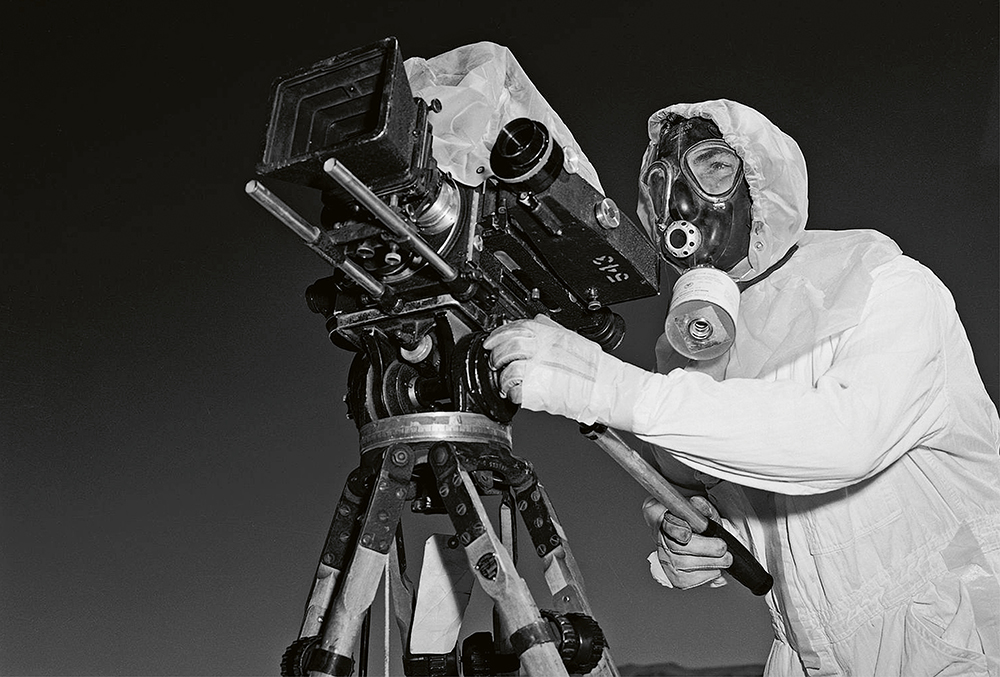
A Lookout Mountain Laboratory cameraman wearing a protective suit ©National Archives and Records Administration
How do you see the narratives in the book informing our current moment?
Do you see evidence that we are still operating under the same social/military/techo/sexist attitudes that justified the development and use of the bomb?
Well, for one thing, nuclear weapons are still very much with us, unfortunately. Perhaps the Russian invasion of Ukraine has brought the possible threat of a nuclear attack back into wider public consciousness, but we are still a long way from nuclear disarmament. Even the Comprehensive Nuclear-Test-Ban Treaty, which was adopted by the UN General Assembly in 1996, still hasn’t legally entered into force since eight countries, including China and the U.S., have yet to ratify. Geophysical monitoring detected a likely atomic bomb ‘test’ in North Korea in January 2016, which really wasn’t so long ago.
There are also many histories of nuclear colonialism that need reckoning with, and not only in the U.S., but with regards British programmes in Kiritimati and French detonations in colonised Algerian Sahara. As I write in Klara and the Bomb, there are a number of ongoing health and environmental issues in the Marshall Islands directly linked to U.S. nuclear operations which have yet to be resolved to the satisfaction of the Marshallese.
And of course the military-industrial complex remains deeply tied to the American domestic economy, even if its some of its cultural influence has been supplanted by silicon valley tech bros.
The book is published by the Eriskay Connection and available here https://www.eriskayconnection.com/home/123-klara-and-the-bomb.html
Crystal Bennes is an American artist and writer based in Scotland. Her practice is grounded in long-term projects which foreground archival research, durational fieldwork and material experimentation. Recent bodies of work include a photo essay on an artificial island made of radioactive, industrially-produced fertiliser waste and a weed garden exploring a nineteenth-century myth of accidental plant migration from Italy to Denmark. She recently completed a practice-based PhD on histories of gendered representations of nature in the sciences and feminist critiques of physics.
Instagram: @crystalbennes
Posts on Lenscratch may not be reproduced without the permission of the Lenscratch staff and the photographer.
Recommended
-
From Here to the Horizon: Photographs in Honor of Barry LopezApril 3rd, 2024
-
European Week: Kacper KowalskiMarch 4th, 2024
-
Debbie Fleming Caffery: In Light of EverythingFebruary 11th, 2024
-
Jamey Stillings: AtacamaNovember 25th, 2023

